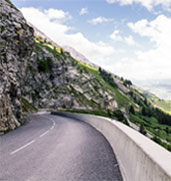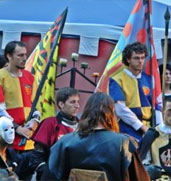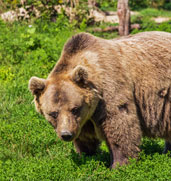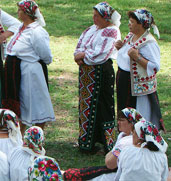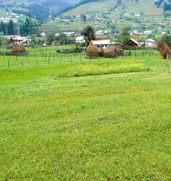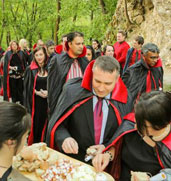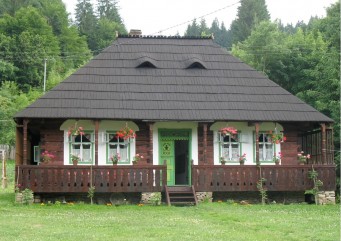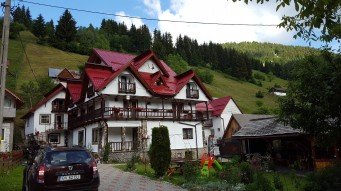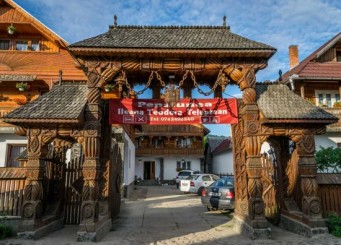In rural houses
GREAT ROUTE IN RURAL HOUSES WITH MARAMURES AND MONASTERIES
Duration: 9 nights / 10 days
Type: fly & drive
Route: Romania - Brasov, Zetea, Bucovina, Maramures, Sibiu, Bucharest
Day 1
Arrival in Bucharest.
Delivery of the rental car to the airport.
Direct departure in the direction of the village of Moieciu de Sus, village located 3 hours of routes, in the Carpathians.
Accommodation and dinner in a tourist pension.
Day 2
Breakfast at Daniela's house.
Possible visits in the region:
- Bran Castle, known as Dracula's Castle. Bran: village located at 40-45 min. from Brasov where you will find a castle named Dracula’s by tourists (www.brancastlemuseum.ro). Actually, the castle is more related to the history of the royal family of Romania, and especially to the life of Queen Mary. It is not much related to Vlad the Impaler, who gave birth to the legend of Dracula – supposedly the prince passed here or he was taken prisoner in the zone.
Visiting time indoors: 30 - 40 min. To this length of time free time is added for shopping in the area for souvenirs around the castle.
- The fortress of Risnov - one of the best preserved medieval settlements in Transylvania. It is located above the limestone hill of the city of Risnov. The oldest parts date back to the 14th century.
- The Valea Cetatii cave - new entry into the tourist circuit
- the Poiana Brasov mountain resort, famous for winter sports and its ski slopes.
- The city of Braşov. one of the most important, powerful and flourishing cities in its region. Thanks to its geographical position and its infrastructure, it allows the development of many economic and cultural activities.
Points of interest:
- The museum of the First Romanian School, a museum that exposes the first books printed in Romanian language
- The Black Church - a famous church in Gothic style begun in 1384 and finished in 1477. It received the current denomination after the general fire of 1689.
- The church of Saint Nicholas - dating from the 14th century.
- The walls of the old fortifications
- Tampa Mountain
The entire region of Brasov has a German-medieval character.
Possible visits in Sinaia:
- The Peles and Pelisor castles in Sinaia.
- The monastery of Sinaia, built in 1695, from the order of Prince Mihail Cantacuzino and named after Mount Sinai.
Sinaia: The history of the place begins with the monastery of Sinaia around which the entire city was built, today a holiday destination.
The castle of Peles in Sinaia (www.peles.ro). The castle was built between 1875 and 1914 and was summer residence of the kings of Romania, the Hohenzollern-Sigmaringen family. It is considered as one of the richest castles in the German family.
The visit of the interior takes about 40 min.
Other visits:
- the Cantacuzino Palace in Busteni, recently entered in the tourist circuit. Built in 1911, the castle has a Neo-Romanian architectural style and a great historical value. The entrance hall includes a unique heraldic collection. The surrounding park has waterfalls, fountains and a cave.
- the former royal wineries of Azuga, now owned by the English company Halewood.
In the afternoon, return to Daniela's house. Accommodation, dinner and overnight.
Day 3
Breakfast at Daniela's house.
Departure from Moeciu de Sus towards Zetea (small village in the Hungarian part of Transylvania).
Cities on the road: Brasov - Rupea - the village of Vanatori. In this village, take a right towards Odorheiu Secuiesc.
It is worth to continue to Sighisoara from Vanatori (10 km further) and then back and go in the direction of Odorheiu Secuiesc.
Sighisoara: visit the interior of the fortress. This city is also known as the birthplace of Vlad the Impaler - the prince who gave birth to the legend of Dracula.
Sighisoara is a medieval fortress of the 12th century, UNESCO listed. The Clock Tower keeps the entrance in the Fortress that has a system of walls of almost 1 km, 9 defense towers, 160 houses, churches and a long history. Sighisoara has a unique charm, it is the gateway into a medieval world.
http://infosighisoara.ro/
http://www.sighisoara-transilvania.ro/index.php?option=com_frontpage&lang=en
After the exit of Odorheiu Secuiesc in the direction of Miercurea Ciuc (in the village of Bradesti), there is a plaque that indicates the town of Zetea (10 km). In Zetea, once past the church and the shop, it’s the second street on the right, continue along this street until you find the Zsogod street that goes to the left.
Accommodation and dinner.
Day 4
After breakfast, departure in direction of Bucovina, taking the route Zetea - Gheorgheni - Lacu Rosu - Bicaz - Piatra Neamt - Targu Neamt - Gura Humorului - Vama.
Possible visits during the day:
- The Red Lake - formed from an earth fall.
- The Bicaz gorge - the narrowest in the country
- The monasteries of Moldova - Agapia, Neamtu, Varatec. They are the monasteries of Moldova, different from those of Bucovina but equally interesting. Agapia has a real village inside the monastery, with houses where the nuns live, Varatec has paintings by the most important Romanian painter Nicolae Grigorescu, Neamtu is the largest and hosts monks.
- The Tirgu Neamt fortress - newly renovated, impresses with its location and view from above.
- The natural park of Vanatori Neamt.
Accommodation in a tourist pension (rural house) in the village of Vama. Dinner.
Zetea - Vama Distance: 300 km.
Day 5
Breakfast.
Day dedicated to the visit of the monasteries - UNESCO monuments, famous for the original exterior frescoes.
With original paintings from the 16th-17th century, the monasteries are spectacular and surprising: Sucevita, Moldovita, Voronet, Humor.
Websites:
http://www.ceramicamarginea.ro/en/index.php
http://www.manastiri-bucovina.go.ro/bukovina.htm
http://www.turism.ro/espanol/moldova.php
Possible visits:
- The monasteries of Sucevita, Moldovita, Humor, Voronet, Arbore.
- Marginea ceramics workshops.
- The city of Suceava.
- Dragomirna and Putna Monasteries (further than the other monasteries)
- The Painted Eggs Museum, in the village of Vama.
The circle of the 4 monasteries covers a distance of 150 km with the town of Marginea included.
Return to the same house for dinner and night.
Day 6
Breakfast at Florica's house.
Departure towards the region of Maramures. Road to take: Vama - Campulung Moldovenesc - Iacobeni - Borsa - Moisei - Sacel. In the village of Sacel, take the more traditional road and do not go towards Sighetu Marmatiei as is indicated but go from Moisei to Bistrita and turn after a few km towards Sacel - Vadu Izei. There will be churches in wood, large wooden doors, traditional houses. If it is Sunday, people leave the church in traditional dress.
Towns to see: Rozavlea, Barsana with its monastery - the largest in the region, with all wooden buildings, Bogdan Voda.
Arrival at the house of Ileana in the village of Vadu Izei and installation for 2 nights.
Day 7
Breakfast.
Visits in the region:
- The city of Sighetu Maramatiei (the former communist jail, the house of Elie Wiesel, the village museum).
- The merry cemetery of Sapanta, famous for its sculpted and decorated crosses.
- Other villages in the vicinity of Vadu Izei. Ask the people there.
- The train in Viseu de Sus. Ask for more details.
Day 8
Breakfast at Ileana's house.
Departure from the village of Vadu Izei in the direction of Baia Mare. Continue towards Dej - Gherla and then towards the city of Cluj - Napoca.
Possible stop and visit of the centre.
Possible visits:
- The monastery of Nicula, near Gherla (before Cluj)
- The city of Cluj Napoca - the Saint Michael church in the centre, the Orthodox cathedral, the university. Cluj Napoca was capital of Transylvania,
- The city of Alba Iulia with Vauban style fortress and cathedrals. The fortress has had a long process of renovation.
- The city of Sibiu
Sibiu: city with medieval centre, one of the most "alive" places in the country. It was the European Capital of Culture in 2007 and remains a centre for many events of all kinds. The city has modern and charming accommodation facilities and restaurants with specific Romanian atmosphere at night.
The visit of the city is done on foot and includes: The Big Square, the Haller House, the Teutsch House, the Small Square, the Bridge of Lies, the Huet Square, the Evangelical Church, the Metropolitan Church, the Walls of the fortress, the Schiller Square.
After the city of Sibiu, take the direction of Sebes. After 15 km, take left towards the village of Sibiel. Accommodation and dinner at Cristina Banciu's house.
Distance Sighetu Marmatiei - Sibiu: 380 km.
Day 9
Breakfast at the hotel.
Departure from Sibiu, taking the valley of the river Olt, one of the most interesting passages of the Carpathians. It is 47 km long, being the longest gorge of Romania.
En route, you can visit the monastery of Cozia, one of the oldest in the region.
Possible stop in Curtea de Arges, where the kings of Romania where buried and legends stil exist. The city houses a various number of medieval churches. Important churches are Biserica Domneasca (The Royal Church) build by Mircea the Brave, monarch of Walachia who reigned between 1386-1418. The structure resembles a stone fortress, connected through catacombs with a watchtower situated on a nearby hill.
Curtea de Argeş is a city of varied cultural activities with various festivals of music and poetry. To the north are the ruins of Poienari Castle.
If the season allows, you can take the route of Transfagarasan, the most spectacular in the country.
After Pitesti, entrance on the road to Bucharest.
Distance Sibiu - Bucharest: 300 km, without detours for visits.
Bucharest: Romania's capital is a city that offers a variety of architectural styles: French from the early 20th century, communist and modern.
The city was mentioned for the first time in 1459 in connection with Vlad the Impaler.
Called "the little Paris", the city surprises with its monuments and various buildings.
Important places:
- The Revolution Square - where the Revolution of 1989 happened, that led to the change of the communist system.
- The old building of the Communist Party, the Royal Palace, the Romanian Athenaeum, the University, the University Square, the National Theatre, the Military Centre, the Opera, Cotroceni Palace, the Academy of Military Studies
- The Parliament - the second largest building in the world, after the Pentagon
- The Arc of Triumph, the House of the Free Press, parks, Victoria Square, Romana Square etc.
- The old town with the ruins of the former palace of princes, where Vlad the Impaler lived, Hanul lui Manuc, very lively streets today, with historic buildings.
Overnight at hotel in Bucharest, Rin Central 4 * type, or similar.
Day 10
Breakfast at the hotel.
Return the car, according to flight schedule and end of services.





